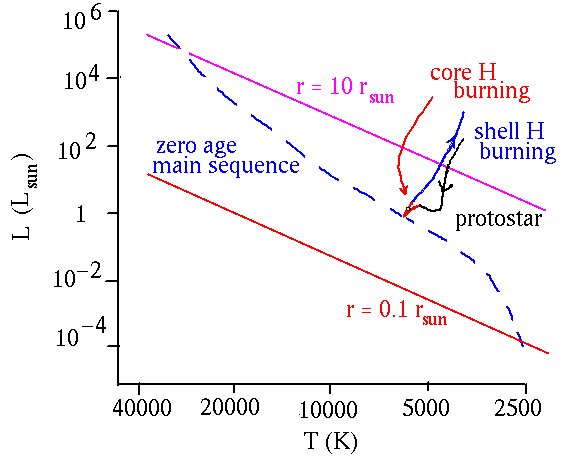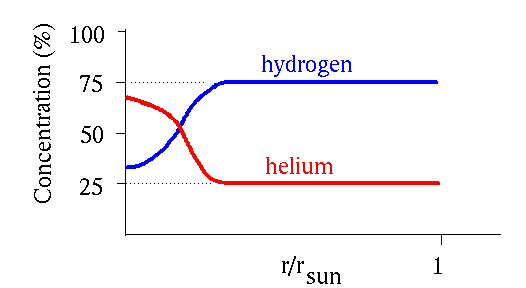Life on the Main Sequence
Once a star is born, it spends its active life somewhere on the main
sequence. Its place on the main sequence is determined by its mass.
Astronomers make computer models of the evolution of stars.
- Balance pressure against gravity.
- Compression of gas raises its temperature.
- Heat flows out toward the surface by photon radiation or convection.
- If the temperature and pressure are high enough, nuclear fusion
occurs.
- Fusion gradually increases the amount of helium and decreases
the amount of hydrogen.
For a star like the Sun
- It takes about 0.1 x 106 years a collapsing gas cloud to
form a protostar.
- It takes about 10 x 106 years for the protostar to
be compressed enough to raise its core temperature to 10 x 106 K,
at which point hydrogen burning in the core commences and the protostar
becomes a star.
- The newborn star continues to shrink and its surfact to warm for
another 20 x 106 years, when it reaches a state of stable
equilibrium.
- It is now a "zero age main sequence" star.
- Now hydrogen burning continues in the core for some 10,000 x
106 years, that is 10 x 109 years.
- The star is on the main sequence.
- It stays on the main sequence for a long time compared to the
time it took for the star to be born.
- As the hydrogen burns, the star's luminosity increases slowly.
- When the hydrogen in the core is exhausted, the star gets bigger
and more luminous as hydrogen burns vigorously in a shell about the core.
(We will discuss this shortly.)
 .
.
According to this kind of stellar model, here is where we are now
 .
.
(The concentrations here are percentages by mass, rather than by numbers of nuclei.)
The same sort of model can be applied to stars with masses that
are smaller or larger than that of the Sun.
- The general picture is similar.
- Star Birth:
- Less massive stars spend more time in the starbirth process.
- More massive stars spend less time in the starbirth process.
- Main sequence luminosity and temperature:
- Less massive stars are less luminous and have cooler surfaces.
- More massive stars are more luminous and have hotter surfaces.
- Main sequence lifetime:
- The lifetime is the amount of fuel to be burned divided by the
rate at which the fuel is being burned.
- The amount of fuel available is roughly proportional to the mass
of the star. (Roughly, because it is only the fuel at the center
that counts here.)
- The rate at which the fuel is being burned is proportional
to the luminosity.
- Less massive stars have somewhat less fuel but are burning it
much more slowly. Thus they longer lifetimes than the Sun.
- More massive stars have somewhat more fuel but are burning it
much faster. Thus they shorter lifetimes than the Sun.
Evidence for astronomers' model of stars
Astronomers have a model of stars as giant nuclear
reactors that burn hydrogen to make helium. This model is backed up
with detailed computer models based on physical principles.
One piece of evidence for this picture is that the stellar models
do a good job of predicting the existence of the main sequence and
where it should be on the HR diagram.
Another kind of evidence comes from looking at clusters of stars. Here
is a sketch of what one sees for the HR diagram of a cluster of the
type known as a globular cluster.

The evidence from this diagram is that it is about 10 billion years old.
- Stars whose predicted lifetimes
are less than that have left the main sequence.
- Stars whose predicted
lifetimes are more than that are still there.
- (The lowest luminosity
stars are not plotted because they are too hard to see.)

ASTR 122 course home page
Updated 5 December 2007
Davison E. Soper, Institute of Theoretical Science,
University of Oregon, Eugene OR 97403 USA
 .
. .
. .
.
